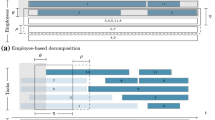Abstract
Staff scheduling is one of the most relevant issues among production planning managers. The problem is to set up an appropriate schedule for various employees to maximize the performance measurement. There are different conflicting criteria with any scheduling problem such as cost minimization, efficiency maximization, etc. The proposed model of this paper develops a new multiobjective decision-making scheduling problem, and the resulted problem is solved using two different techniques of goal programming and augmented epsilon constraint. The implementation of the new proposed model is demonstrated with a real-world case study, and they are analyzed. The preliminary results indicate that the epsilon-constraint method somewhat performs better than goal programming technique.
Similar content being viewed by others
References
Chu SCK, Zhu M (2008) Data and GP modeling framework for manpower planning. The case of fixed-length duties. Department of Mathematics, University of Hong Kong, Hong Kong
Detienne B, Péridy L, Pinson E, Rivreau D (2009) Cut generation for an employee timetabling problem. Eur J Oper Res 197:1178–1184
Matta RD, Peters E (2009) Developing work schedules for an inter-city transit system with multiple driver types and fleet types. Eur J Oper Res 192:852–865
Lasry A, McInnis D, Soumis F, Desrosiers J, Solomon M (2000) Air Transat uses ALTITUDE to manage its aircraft routing, crew pairing, and work assignment. Interfaces 30(2):35–41
Ernst A, Jiang H, Krishnamoorthy M, Nott H, Sier D (2001) An integrated optimization model for train crew management. Ann Oper Res 108:211–224
Caprara A, Monaci M, Toth P (2001) A global method for crew planning in railway applications. In: Voss S, Daduna J (eds) Computer-aided scheduling of public transport lecture notes in economics and mathematical systems, vol. 505. Springer, Berlin, pp 17–36
Chu S, Chan E (1998) Crew scheduling of light rail transit in Hong Kong: from modeling to implementation. Comput Oper Res 25(11):887–894
Glen J (1975) A dynamic programming model for work scheduling in a shipyard. Oper Res Q 26(4):787–799
Sarin S, Aggarwal S (2001) Modeling and algorithmic development of a staff scheduling problem. Eur J Oper Res 128:558–569
Robbins TR (2007) Addressing arrival rate uncertainty in call center workforce management. Penn State University, State College, Doctoral dissertation
Ernst AT, Jiang H, Krishnamoorthy M, Sier D (2004) Staff scheduling and rostering: a review of applications, methods and models. Eur J Oper Res 153:3–27
Topaloglu S (2009) A shift scheduling model for employees with different seniority levels and an application in healthcare. Eur J Oper Res 198:943–957
Massey L, Esain A, Wallis M (2009) Managing the complexity of nurse shortages: a case study of bank and agency staffing in an acute care Trust in Wales, UK. Int J Nurs Stud 46:912–919
Vanhoucke M, Maenhout B (2009) On the characterization and generation of nurse scheduling problem instances. Eur J Oper Res 196:457–467
Tsai CC, Li SHA (2009) A two-stage modeling with genetic algorithms for the nurse scheduling problem. Expert Syst Appl 36:9506–9512
Beliën J (2007) Exact and heuristic methodologies for scheduling in hospitals: problems, formulations and algorithms. Decision Sciences and Information Management, Faculty of Economics and Applied Economics, Katholieke Universities Leuven, Belgium, Doctoral dissertation
An L, Subramanian D (2009) Integrated short-term staffing and long-term resource action planning for services projects. IBM T.J. Watson Research Center
Sureshkumar MR, Madhusudanan Pillai V (2012) An efficient method to reduce relative capacity shortage using annualised hours planning. Int J Adv Manuf Technol 65(1–4):571–580
Sureshkumar MR, Madhusudanan Pillai V (2012) Planning annuaulised hours when spike in demand exists. Int J Ind Eng Comput 3:313–320
Heydari M, Mahdavi Mazdeh M, Bayat M (2013) Scheduling stochastic two-machine flow shop problems to minimize expected makespan. Decision Science Letters 2:163–174. doi: 10.5267/j.dsl.2013.04.005
Sabar M, Montreuil B, Frayret JM (2009) A multi-agent-based approach for personnel scheduling in assembly centers. Eng Appl Artif Intell 22:1080–1088
Hwang CL, Masud A (1979) Multiple objective decision making—methods and applications: a state-of-the-art survey. Lecture notes in economics and mathematical systems, vol. 164. Springer, Berlin
Mavrotas G (2009) Effective implementation of the e-constraint method in Multi-Objective Mathematical Programming problems. Appl Math Comput 213:455–465
Chankong V, Haimes YY (1983) Multiobjective decision making: theory and methodology. North-Holland, New York
Cohon JL (1978) Multiobjective programming and planning. Academic, New York
Xidonas P, Mavrotas G, Psarras J (2010) Equity portfolio construction and selection using multiobjective mathematical programming. J Glob Optim 47:185–209
Steuer RE (1986) Multiple criteria optimization: theory, computation, and application. Krieger, Malabar
Miettinen KM (1998) Nonlinear multiobjective optimization. Kluwer Academic, Boston
Author information
Authors and Affiliations
Corresponding author
Rights and permissions
About this article
Cite this article
Sadjadi, S.J., Heidari, M. & Alinezhad Esboei, A. Augmented ε-constraint method in multiobjective staff scheduling problem: a case study. Int J Adv Manuf Technol 70, 1505–1514 (2014). https://doi.org/10.1007/s00170-013-5352-8
Received:
Accepted:
Published:
Issue Date:
DOI: https://doi.org/10.1007/s00170-013-5352-8




